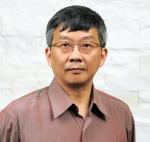Electronic transport properties of quantum-well states in ultrathin Pb (111) films
- Citation:
- Miyata, N., Horikoshi K., Hirahara T., Hasegawa S., Wei C. M., & Matsuda I. (2008). Electronic transport properties of quantum-well states in ultrathin Pb (111) films. Physical Review B. 78, 6., Dec, Number 24
Abstract:
Electrical conduction mechanism in ultrathin Pb (111) films formed on the Si(111)root 3x root 3-Pb surface has been investigated by means of in situ conductivity measurements, angle-resolved photoemission spectroscopy, and first-principles calculations. To investigate the origin of the bilayer oscillation observed in the present conductivity measurement, we perform some simulations based on the calculated band structure. They reveal that the density of states near the Fermi level cannot explain the bilayer oscillation, therefore, exclusively assigning it to the relaxation time. Surface roughness during the bilayer film growth seems to play a crucial role in the bilayer oscillation of the relaxation time.
Notes:
ISI Document Delivery No.: 391PYTimes Cited: 8Cited Reference Count: 34Cited References: BLOCHL PE, 1994, PHYS REV B, V50, P17953, DOI 10.1103/PhysRevB.50.17953 Chiang TC, 2000, SURF SCI REP, V39, P181, DOI 10.1016/S0167-5729(00)00006-6 Czoschke P, 2003, PHYS REV LETT, V91, DOI 10.1103/PhysRevLett.91.226801 Dil JH, 2006, PHYS REV B, V73, DOI 10.1103/PhysRevB.73.161308 Dil JH, 2007, PHYS REV B, V75, DOI 10.1103/PhysRevB.75.161401 Eom D, 2006, PHYS REV LETT, V96, DOI 10.1103/PhysRevLett.96.027005 Fuchs K, 1938, P CAMB PHILOS SOC, V34, P100 Guo Y, 2004, SCIENCE, V306, P1915, DOI 10.1126/science.1105130 HASEGAWA S, 1992, PHYS REV LETT, V68, P1192, DOI 10.1103/PhysRevLett.68.1192 Hasegawa S, 2003, SURF REV LETT, V10, P963, DOI 10.1142/S0218625X03005736 Hirahara T., 2004, e-Journal of Surface Science and Nanotechnology, V2, DOI 10.1380/ejssnt.2004.141 Hong HW, 2003, PHYS REV LETT, V90, DOI 10.1103/PhysRevLett.90.076104 Hupalo M, 2002, PHYS REV B, V65, DOI [10.1103/PhysRevB.65.205406, 10.1103/PhysRevB.65.115406] JALOCHOWSKI M, 1988, PHYS REV B, V38, P5272, DOI 10.1103/PhysRevB.38.5272 JALOCHOWSKI M, 1992, PHYS REV B, V45, P13607, DOI 10.1103/PhysRevB.45.13607 Jalochowski M, 1996, PHYS REV LETT, V76, P4227, DOI 10.1103/PhysRevLett.76.4227 Kresse G, 1996, PHYS REV B, V54, P11169, DOI 10.1103/PhysRevB.54.11169 Kresse G, 1999, PHYS REV B, V59, P1758, DOI 10.1103/PhysRevB.59.1758 Matsuda I, 2005, PHYS REV B, V71, DOI 10.1103/PhysRevB.71.235315 MEADEN GT, 1965, ELECTRICAL RESISTANC, P16 Ozer MM, 2006, NAT PHYS, V2, P173, DOI 10.1038/nphys244 Ozer MM, 2005, PHYS REV B, V72, DOI 10.1103/PhysRevB.72.113409 Ozer MM, 2007, SCIENCE, V316, P1594, DOI 10.1126/science.1142159 Perdew JP, 1996, PHYS REV LETT, V77, P3865, DOI 10.1103/PhysRevLett.77.3865 Pfennigstorf O, 2002, PHYS REV B, V65, DOI 10.1103/PhysRevB.65.045412 SHIRLEY EL, 1995, PHYS REV B, V51, P13614, DOI 10.1103/PhysRevB.51.13614 SONDHEIMER EH, 1952, ADV PHYS, V1, P1, DOI 10.1080/00018735200101151 TANIKAWA T, 2003, E J SURF SCI NANOTEC, V1, P50 TRIVEDI N, 1988, PHYS REV B, V38, P12298, DOI 10.1103/PhysRevB.38.12298 Upton MH, 2004, PHYS REV LETT, V93, DOI 10.1103/PhysRevLett.93.026802 Upton MH, 2005, PHYS REV B, V71, DOI 10.1103/PhysRevB.71.033403 Vilfan I, 2002, PHYS REV B, V66, DOI 10.1103/PhysRevB.66.241306 Wei CM, 2007, PHYS REV B, V75, DOI 10.1103/PhysRevB.75.195417 Wei CM, 2002, PHYS REV B, V66, DOI 10.1103/PhysRevB.66.233408Miyata, Nobuhiro Horikoshi, Kotaro Hirahara, Toru Hasegawa, Shuji Wei, C. M. Matsuda, IwaoJapan Society for the Promotion of ScienceWe are grateful to M. C. Tringides for helpful discussion. We would like to thank Rei Hobara for his assistance with the ARPES experiment. This work has been supported by Grants-In-Aid from Japan Society for the Promotion of Science.AMER PHYSICAL SOCCOLLEGE PK

